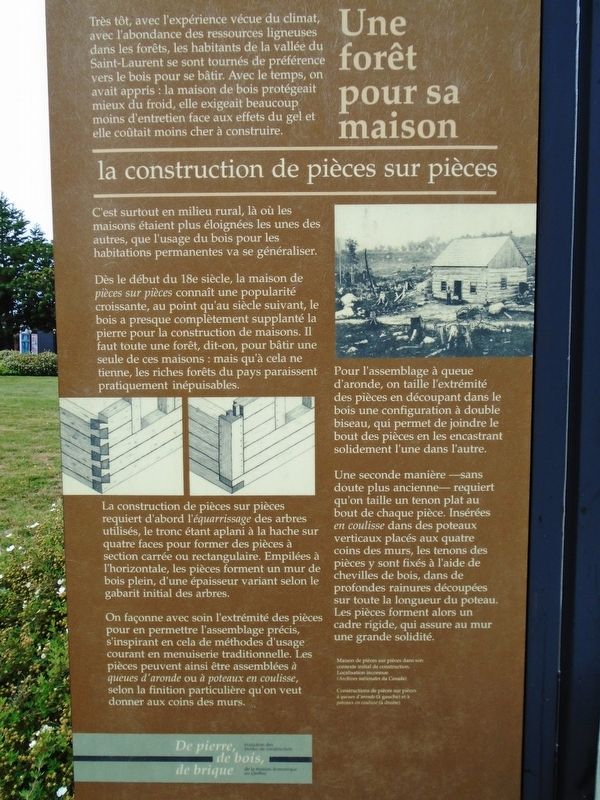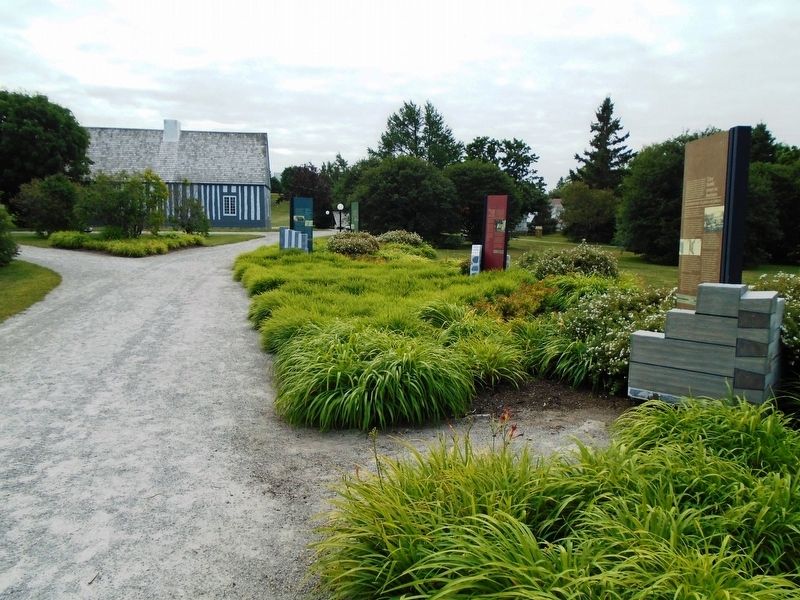Une forêt pour sa maison / A forest for his house
la construction de pièces sur pièces / the construction of pieces on pieces
— De pierre, de bois, de brique / Stone, Wood, Brick —
C'est surtout en milieu rural, là où les maisons étaient plus éloignées les unes des autres, que l'usage du bois pour les habitations permanentes va se généraliser.
Dès le début du 18e siècle, la maison de pièces sur pièces connaît une popularité croissante, au point qu'au siècle suivant, le bois a presque complètement supplanté la pierre pour la construction de maisons. Il faut toute une forêt, dit-on, pour bâtir une seule de ces maisons : mais qu'à cela ne tienne, les riches forêts du pays paraissent pratiquement inépuisables.
La construction de pièces sur pièces requiert d'abord l'équarrissage des arbres utilisés, le tronc étant aplani à la hache sur quatre faces pour former des pièces à section carrée ou rectangulaire. Empilées à l'horizontale, les pièces forment un mur de bois plein, d'une épaisseur variant selon le gabarit initial des arbres.
On façonne avec soin l'extrémité des pièces pour en permettre l'assemblage précis, s'inspirant en cela de méthodes d'usage courant en menuiserie traditionnelle. Les pièces peuvent ainsi être assemblées à queues d'aronde ou à poteaux en coulisse,
selon la finition particulière qu'on veut donner aux coins des murs.Pour l'assemblage à queue d'aronde, on taille l'extrémité des pièces en découpant dans le bois une configuration à double biseau, qui permet de joindre le bout des pièces en les encastrant solidement l'une dans l'autre.
Une seconde manière —sans doute plus ancienne— requiert qu'on taille un tenon plat au bout de chaque pièce. Insérées en coulisse dans des poteaux verticaux placés aux quatre coins des murs, les tenons des pièces y sont fixés à l'aide de chevilles de bois, dans de profondes rainures découpées sur toute la longueur du poteau. Les pièces forment alors un cadre rigide, qui assure au mur une grande solidité.
[Légendes des illustrations lues]
• Maison de pièces sur pièces dans son contexte initial de construction. Localisation inconnue.
• Constructions de pièces sur pièces à queues d'aronde (à gauche) et à poteaux en coulisse (à droite).
Especially in rural areas, where houses are more distant from each other, the use of wood for permanent dwellings became widespread.
From the beginning of the 18th century the piece-parts house became increasingly popular so that through the century, wood almost completely supplanted stone for house construction. It takes a whole forest, the saying goes, to
The construction of pieces on pieces first requires the rendering of the trees, with the trunk being flattened by an ax on four sides to form pieces with square or rectangular section. Stacked horizontally, the pieces form a solid wooden wall, with thickness varying according to the initial size of the trees.
The piece ends are carefully molded to allow precise assembly, inspired by methods commonly used in traditional carpentry. The pieces are assembled with dovetails or poles behind the scenes, depending on the particular finish one wants to give to the wall corners.
For a dovetail assembly, the ends of the wood pieces are cut into a double bevel configuration which allows the end pieces to be joined by embedding them solidly into one another.
A second way - probably older - requires that a flat post be cut at the end of each piece. Inserted behind the scenes in vertical posts placed at the four corners of the walls, the tenons of the pieces are fixed with wooden pegs, in deep grooves cut along the entire length of the post. The pieces then form a rigid frame, which ensures a wall of great strength.
[Illustration captions read]
• Pieces on pieces construction;
• Pieces on pieces house after initial construction. Location unknown.
Topics. This historical marker is listed in these topic lists: Architecture • Horticulture & Forestry • Settlements & Settlers.
Location. 48° 29.069′ N, 68° 29.728′ W. Marker is in Rimouski, Québec, in Rimouski-Neigette. Marker is on boulevard du Rivage (Québec Route 132), on the right when traveling north. Marker is on the grounds of Maison Lamontagne House Historic Site. Touch for map. Marker is at or near this postal address: 707 boulevard du Rivage, Rimouski QC G5L 7L3, Canada. Touch for directions.
Other nearby markers. At least 8 other markers are within walking distance of this marker. Un jeu de blocs... d'argile / A set of blocks ... of clay (here, next to this marker); Pierre des champs... pierre des villes / Stones of the fields... stones of the cities (a few steps from this marker); Façons de France ...en Amérique / French Ways ...in America (a few steps from this marker); Du moulin à la maison / From the mill to the house (a few steps from this marker); Le temps de s'établir / Time to Settle (a few steps from this marker); Sur un squelette... de bois / On a skeleton... of wood (within shouting distance of this marker); La maison Londonienne / The London house (within shouting distance of this marker); La maison urbaine en Nouvelle-France / The Urban House in New France (within shouting distance of this marker). Touch for a list and map of all markers in Rimouski.
Regarding Une forêt pour sa maison / A forest for his house. Marker is one of a series highlighting the evolution of Quebec domestic architecture, titled, Stone, Wood, Brick.
Also see . . . Maison Lamontagne House Historic Site. (Submitted on November 30, 2018, by William Fischer, Jr. of Scranton, Pennsylvania.)
Credits. This page was last revised on January 20, 2020. It was originally submitted on November 30, 2018, by William Fischer, Jr. of Scranton, Pennsylvania. This page has been viewed 146 times since then and 11 times this year. Photos: 1, 2. submitted on December 1, 2018, by William Fischer, Jr. of Scranton, Pennsylvania.

